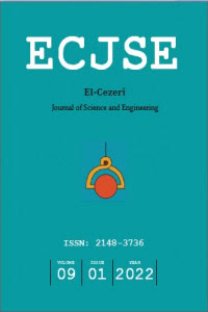Removal of Suspended Particles from Wastewater by Conventional Flotation and Floc-flotation
Atıksu Arıtımı, Flokülasyon, Flotasyon, Floc-flotasyonu
Removal of Suspended Particles from Wastewater by Conventional Flotation and Floc-flotation
Wastewater treatment, Flocculation, Flotation, Floc flotation,
___
- Gregory, J., Particles in Water: Properties and Process, University College London, 2005, UK.
- Oliveira, C., Rubio, J., “A Short overview of the formation of aerated of flocs and their applications in solid/liquid separation by flotation”, Minerals Engineering, 2012, 39: 124-132.
- Colic, M., Morse, W., Miller, J.D., “The development and application of centrifugal flotation systems in wastewater treatment”, Int. J. Environment and Pollution, 2007, 30(2): 296-312.
- Hocking, M.B., Klimchuk, K.A., Lowen, S., “Polymeric flocculants and flocculation”, Polymer Reviews, 1999, 39:2, 177-203.
- Boltoa, B., Gregory, J., “Organic polyelectrolytes in water treatment”, Water Research, 2007, 41: 2301-2324.
- Kitchener, J. A., “The froth flotation process: Past, Present, and Future, The scientific basis of flotation”, 1984, 3–52, Martinus Nijhoff Publishers, Hague, the Netherlands.
- Collins, G.L., Jameson, G. J., “Experiments on the flotation of fine particles”, The Influence of Particle Size and Charge, Chemical Engineering Science, 1976, 31: 985-991.
- Fuerstenau, D.W., “Fine particle flotation. In: fine particle processing”, Proceedings International Symposium, 1980, 1: 669–705.
- Matis, K. A, Flotation Science and Engineering, 1995, 584 p, Marcel Dekker: New York.
- Jameson, G.J., “Advances in fine and coarse particle flotation”, Canadian Metallurgical Quarterly, 2010, 49(4): 325-330.
- Trahar, W.J., Warren, L.J., “The Floatability of fine particles- A review”, International Journal of Mineral Processing, 1976, 3: 103-131.
- Tao, D., “Role of bubble size in flotation of coarse and fine particles- A review”, Separation Science and Technology, 2004, 39: 741-760.
- Miettinen, T., Ralston, J. and Fornasiero D., “The limits of fine particle flotation”, Minerals Engineering, 2010, 23: 420–437.
- Abd El-Rahiem, F.H., “Recent trends in the flotation of fine particles”, Journal of Mining Word Express, 2014, 3: 63-67.
- Fuerstenau, M.C., Jameson, G., Yoon, R.H., Froth flotation, A Century of Innovation, Society for Mining Metallurgy & Exploration.
- Taşdemir, T., Başaran, H.K., “Floatability of suspended particles from wastewater of natural stone processing by floc-flotation in mechanical cell”. El-Cezeri Journal of Science and Engineering, 2020, 7(2): 358-370.
- Song, S., Lopez-Valdivieso, A., Reyes-Bahena, J.L., Lara-Valenzuela, C. “Floc flotation of galena and sphalerite fines. Minerals Engineering, 2001, 14(1): 87-98.
- Sadowski, Z., Polowczyk, I., “Agglomerate flotation of fine oxide particles”, Int. J. Miner. Process, 2004, 74: 85-90.
- Zhang, T., Qin, W., “Floc-flotation of jamesonit fines in aqueous suspensions induced by ammonium dibutyl dithiophosphate”, J. Cent. South Univ. 2015, 22: 1232-1240.
- Chen, P., Li, H., Yi, H., Jia, F., Yang, L., Song, S., “Removal of graphene oxide from water by floc-flocculation”, Separation and Purification Technology, 2018, 202: 27-33.
- Baichenko, A.A., Rulev, N.N. Baran, A.A., “Floccular micro flotation”, Journal of Mining Science, 1991, 27(6), 579-583.
- Jameson, G.J., “A new concept in flotation column design”, In Sastry, K.V.S. (Ed.), Proceedings of the Column Flotation 1988, Annual Meeting, Society of Mining Engineering, 1988, Phoenix, Arizona.
- Kılıc, H., “Treatment of natural stone wastewaters by flocculation and floc-flotation methods”, MSc Thesis, 2012, Eskişehir Osmangazi University, Turkey.
- Başaran, H.K., Taşdemir, T., “Determination of flocculation characteristics of natural stone powder suspensions in the presence of different polymers”, Physicochemical Problems of Mineral Processing, 2014, 50(1): 169−184.
- Rattanakawin, C., Hogg, R., “Aggregate size distributions in flocculation”, Colloids and Surfaces A: Physicochemical and Engineering Aspects, 2001, 177: 87–98.
- Hogg, R., “The role of polymer adsorption kinetics in flocculation”, Colloids and Surfaces A: Physicochemical and Engineering Aspects, 1999, 146: 253–263.
- Biggs, S., Habgood M., Jameson G.J., Yan Y., “Aggregate structures formed via a bridging flocculation mechanism”, Chemical Engineering Journal, 2000, 80: 13–22.
- Jameson, G.J., “Hydrophobicity, and floc density in induced–air flotation for water treatment”, Physicochemical and Engineering Aspects, 1999, 151: 269-281.
- Yan, Y.D., Jameson, G.J., “Application of the jameson cell technology for algae and phosphorus removal from maturation ponds”, Int. J. Miner. Process, 2004; 73: 23-28.
- Taşdemir, T., Taşdemir, A., Geçgel, Y., “Removal of fine particles from wastewater using induced air flotation”, TOJSAT-The Online Journal of Science and Technology, 2011, 1(3): 14-22.
- ISSN: 2148-3736
- Yayın Aralığı: Yılda 3 Sayı
- Başlangıç: 2013
- Yayıncı: Tüm Bilim İnsanları ve Akademisyenler Derneği
2-Tienilboronik Asid: Spektroskopik, Yapısal ve Molekül Orbital Analizi Üzerine Bir DFT Çalışması
Balsa Çekirdekli Sandviç Kompozitlerin Darbe Davranışlarının Deneysel Olarak İncelenmesi
Dizel Yakıtlı Taşıtlardan Salınan Partikül Maddelerin Mikroyapı ve Kimyasal Karakterizasyonu
Nanomateryallerin Kompozit Malzemelerin Radyasyon Zırhlama Özelliklerine Etkisinin İncelenmesi
Ali Murat SÜRÜCÜ, Serkan SUBAŞI
Ahmet Burçin BATIBAY, Hasan KOTAN, Atilla EVCİN
Endodontide Kullanılan Nikel-Titanyum Atık Eğelerin Sülfürik Asit Liçi İşlemleri ile Geri Kazanımı
Muhammed İhsan ÖZGÜN, Arslan TERLEMEZ, Mahmut AÇMA, Yasin EKER, Ahmet BATIBAY
Elektrikle Çalışan Araçların Elektrik Şebekesine Olan Etkilerinin İncelenmesi
Meral KILIÇARSLAN OUACH, Ertuğrul ÇAM
3D Yazıcılar İçin Tasarlanan Harçlarının Ekstrüde Edilebilirlikleri
Tayfun UYGUNOĞLU, Sevcan BARLAS ÖZGÜVEN
Removal of Suspended Particles from Wastewater by Conventional Flotation and Floc-flotation
